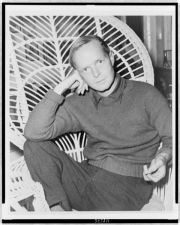 Talk has recently focused on the passing of Norman Mailer, a novelist remembered for many things. As The New York Times put it, he was “a prodigious drinker and drug taker, a womanizer, a devoted family man, a would-be politician who ran for mayor of New York, a hipster existentialist, an antiwar protester, an opponent of women’s liberation and an all-purpose feuder and short-fused brawler, who with the slightest provocation would happily engage in head-butting, arm-wrestling and random punch-throwing.” He was, of course, also a novelist, and, for some, “the greatest novelist of the second half of the American century.” That’s at least how George Packer sized him up on his New Yorker blog.
Talk has recently focused on the passing of Norman Mailer, a novelist remembered for many things. As The New York Times put it, he was “a prodigious drinker and drug taker, a womanizer, a devoted family man, a would-be politician who ran for mayor of New York, a hipster existentialist, an antiwar protester, an opponent of women’s liberation and an all-purpose feuder and short-fused brawler, who with the slightest provocation would happily engage in head-butting, arm-wrestling and random punch-throwing.” He was, of course, also a novelist, and, for some, “the greatest novelist of the second half of the American century.” That’s at least how George Packer sized him up on his New Yorker blog.
For Packer, Mailer achieved his literary greatness when he ventured into the realm of “New Journalism,” helping to create a new genre that brought fresh literary techniques to conventional journalism and historical writing. We need only mention The Executioner’s Song, Mailer’s heavily-researched account of the execution of Gary Gilmore, that earned him the Pulitzer Prize in fiction in 1980.
Although Tom Wolfe officially coined the expression “New Journalism” in 1973 (see the book with the same title and related book review), this literary approach was not entirely new. Other authors had already written masterpieces in the genre but referred to it by different names. More than anyone else, Truman Capote gave form to the genre when he published In Cold Blood in 1965. Famously centered around the 1959 murder of the Clutter family in rural Kansas, this “nonfiction novel” was written to give reality to something Capote believed for 20 years — that journalism was “the most underestimated, the least explored of literary mediums” and that in the right hands “journalism, reportage, could be forced to yield a serious new art form,” (See Capote’s interview with George Plimpton, 1966.)
In Cold Blood originally came out in four successive printings of The New Yorker. And as the current editor of the magazine describes it, “people were literally chasing the delivery trucks down the street.” Quite nicely, you can find the first installment of the novel in the New Yorker’s online archive (for free). It covers the first 70 pages of the currently published book, and here the stage for the rest of the nonfiction novel is set. To paraphrase a line from the recent film starring Philip Seymour Hoffman, it’s in this section of the novel where two Americas collide — the quiet conservative America and its violent underbelly.
Quick afterthought: The New Yorker should consider reprinting the four copies of the magazine which introduced In Cold Blood to the world. I imagine that copyright/contractual issues might stand in the way. But if they didn’t, it could be a pretty exciting media event and reading experience.
![]() Subscribe to Our Feed
Subscribe to Our Feed


[…] , The Right Stuff and The Electric Kool Aid Acid Test . The last two fall into the category of New Journalism which is stylistically written accounts of true events. Wolfe and Truman Capote were two of the […]